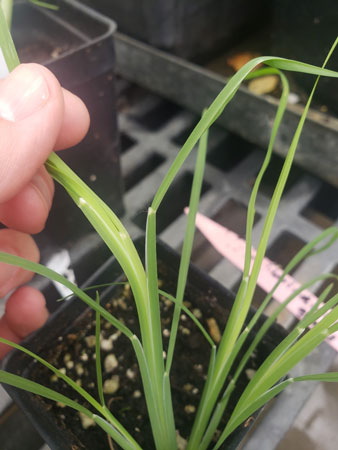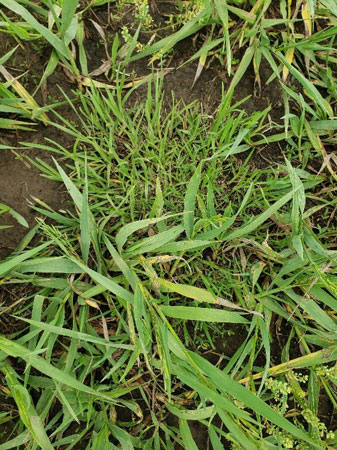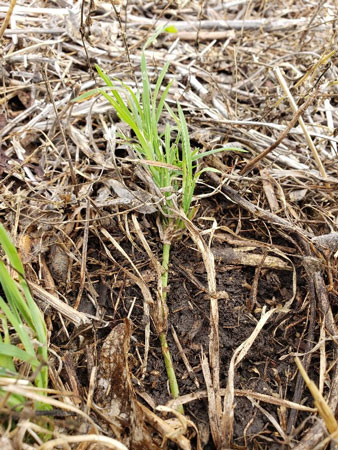Tumble windmillgrass (Chloris verticillata), also called windmillgrass is this month’s World of Weeds feature. Questions have been coming in about how to manage this grass as it can be difficult to control with herbicides once it becomes established in no-till fields.
Ecology of windmillgrass
Tumble windmill grass is native to the United States. It can be found throughout Kansas and is also present in much of the central and southern plains, as well as the Corn Belt and northeastern U.S. It is a warm-season perennial that has historically been a problem in turfgrass, but it has invaded no-till crop fields. It can be found in pastures and rangeland, but is rarely considered a serious problem in those areas. It can be found in all soil types but tends to grow better in sandier soils.
The plant gets its common name from the inflorescence, which detaches to become a tumbleweed. Tumble windmillgrass does hybridize with related species, which may result in some variation in plant features.
Identification
The leaves of tumble windmillgrass are folded and very narrow, about 0.02 to 0.2 inches wide and 0.04 to 0.6 inches long. Mature leaves are generally hairless. The ligule is a short fringed membrane and there are hairs around the ligule. The margins of the leaf sheath do not touch and have wispy hairs along the margins. Also, the margins of the leaf sheath tend to be lighter in color than the rest of the leaf sheath (Figure 1).

Figure 1. Tumble windmillgrass leaf sheath and collar region. Photo by Sarah Lancaster, K-State Research and Extension.
Tumble windmillgrass stems are very flat and grow low to the ground (Figure 2). The flowering stalks are typically 3 to 16 inches tall. The inflorescence is a composed of 6 to 20 branches that occur in 2 to 4 whorls. Each branch 1.5 to 6 inches long. Spikelets are 0.08 to 0.2 inches long with two awns, each about 0.1 to 0.4 inches long. Tumblewindmill grass spreads by seeds, as well as stolons (Figure 3). It has a shallow fibrous root system, with most of the root mass less than 4 inches deep.

Figure 2. Tumble windmillgrass growing in a thin stand of smooth bromegrass. Photo by Sarah Lancaster, K-State Research and Extension.

Figure 3. Tumble windmillgrass rhizomes in a no-till field. Photo by Sarah Lancaster, K-State Research and Extension.
Management
There is limited research regarding management of tumble windmillgrass in agronomic crops. In field studies conducted at K-State during the early 2000’s, pre-emergence application of atrazine with acetochlor, dimethenamid, S-metolachlor, and isoxaflutole provided excellent control of recently-seeded tumble windmillgrass. Glyphosate, which is generally very effective on grasses, and Group 2 herbicides like quizalofop (Assure II, others) and clethodim (Select Max, others) were effective on seedling tumble windmillgrass, but did not control established plants well. Laboratory studies conducted to complement that field work indicated the cause of poor control by herbicides is that very little herbicide moved out of the treated leaf once plants are tillered. Shallow roots also contribute to poor control because they result in stressed plants that do not easily absorb herbicides during hot, dry conditions. Shallow roots are advantageous when using tillage to control tumble windmillgrass.
In recent studies at K-State, one summer tillage event with a sweep plow effectively controlled tumble windmillgrass one month after tillage, with no effect on soil aggregates or soil organic carbon. The difficulty of controlling established stands means that scouting is an especially important component of managing tumble windmillgrass in order to control it before seedlings become established.
References:
Obour et al. 2021; Hennigh et al. 2005
Sarah Lancaster, Extension Weed Management Specialist
slancaster@ksu.edu
Jeanne Falk Jones, Multi-County Agent
jfalkjones@ksu.edu
The use of trade names is for clarity to readers and does not imply endorsement of a particular product, nor does exclusion imply non-approval. Always consult the herbicide label for the most current use requirements.
Tags: World of Weeds windmillgrass